NCERT Solutions for Class 7 English Unit 1 Try Again
Page 16: Let us do these activities before we read
Q1: Who inspires you to do your best?
Ans: This is a personal response question. For example, you could say: My parents inspire me to do my best because they always encourage me to work hard and never give up.
Q2: Work in pairs, identify what you see in the pictures given below. What can we learn from them? Share your answers with your classmates and the teacher.
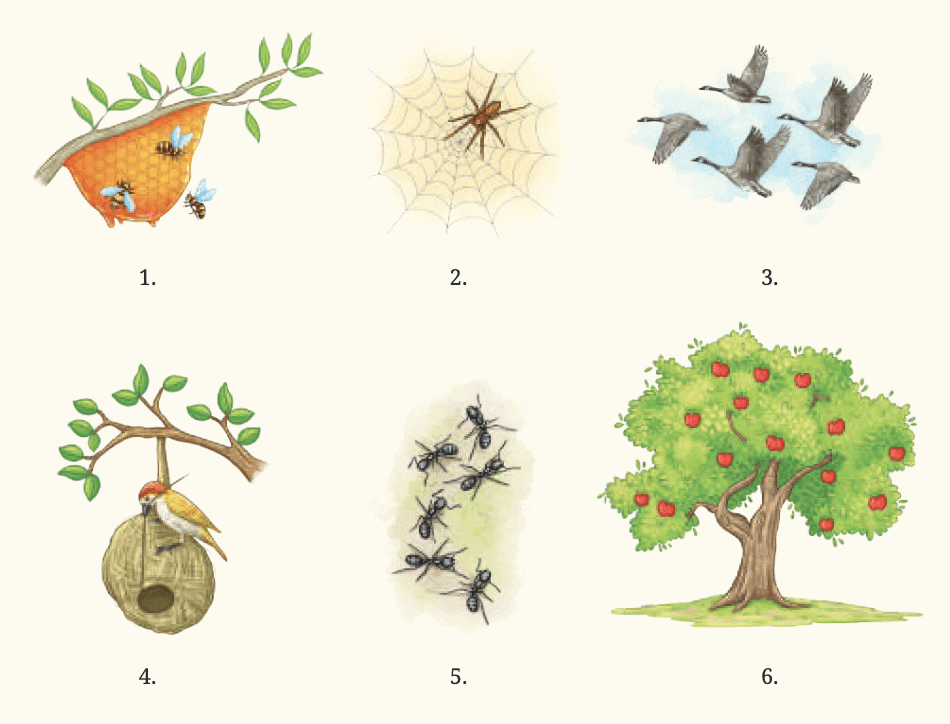
Ans:
- Honey bees: The picture shows honey bees working together in a hive, collecting nectar. We learn the importance of teamwork and hard work, as bees work tirelessly to make honey and support their colony.
- Spider: The picture shows a spider spinning its web, trying again even if the web breaks. We learn to be persistent and keep trying, just like the spider in the poem, even when we face difficulties.
- Migratory birds: The picture shows a flock of migratory birds flying over a long distance. We learn about determination and endurance, as these birds travel thousands of miles to reach their destination.
- Bird: The picture shows a single bird building a nest, which teaches us patience and dedication, as it carefully creates a safe space for its future. It reminds us that success comes from small, consistent efforts.
- Ants: The picture shows a colony of ants, which teaches us the power of collaboration and hard work, as each ant contributes to the collective success. It shows that even the smallest efforts can create something remarkable when combined.
- Apple tree: The picture shows an apple tree growing strong, bearing fruit after years of growth. We learn about patience and perseverance, as the tree takes time to grow, but eventually produces fruit.
Page 19: Let us discuss
QI: Complete the summary of the poem by filling in the blanks with suitable words from the text given in the box below. Share your answers with the teacher.
 The poem, written in a narrative style, tells the story of King Bruce of Scotland, who was feeling 1. _____________ after failing multiple times to achieve something 2. _____________ for his people. In a moment of 3. _____________, he observed a spider trying to reach its web high above. The spider 4. _____________ every time it fell after getting close to its goal. It made nine 5. _____________ and finally succeeded. The king said that the spider had 6. _____________ and so would he. Inspired by the spider’s determination, King Bruce decided to 7. _____________. When he 8. _____________ this time, he ultimately succeeded.
The poem, written in a narrative style, tells the story of King Bruce of Scotland, who was feeling 1. _____________ after failing multiple times to achieve something 2. _____________ for his people. In a moment of 3. _____________, he observed a spider trying to reach its web high above. The spider 4. _____________ every time it fell after getting close to its goal. It made nine 5. _____________ and finally succeeded. The king said that the spider had 6. _____________ and so would he. Inspired by the spider’s determination, King Bruce decided to 7. _____________. When he 8. _____________ this time, he ultimately succeeded.
Ans:
- low
- great
- despair
- mounted
- attempts
- conquered
- strive
- tried
QII. Complete the following sentences suitably
1: We can say that the poet uses the narrative style because _________.
Ans: The poem tells a story about King Bruce and the spider, describing events in a sequence like a tale.
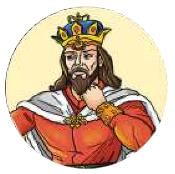 2: The central idea of the poem is ________.
2: The central idea of the poem is ________.
Ans: The central idea of the poem is perseverance and not giving up, even after repeated failures, as shown through the spider’s efforts and King Bruce’s realisation.
QIII. Pick three examples from the poem for each of the following:
1: lines that describe the spider’s efforts.
Ans:
(a) “It soon began to cling and crawl, Straight up with strong endeavour”– This shows the spider’s determination to climb.
(b) “Again it fell and swung below, But again it quickly mounted” – This highlights how the spider kept trying despite failing.
(c) “Steadily, steadily, inch by inch, Higher and higher he got” – This describes the spider’s slow but persistent effort to reach its web.
2: alliteration (the repetition of the same consonant sounds at the beginning of closely connected words).
Ans:
- “cling and crawl” – The repetition of the ‘c’ sound.
- “Bravo, bravo!” – The repetition of the ‘b’ sound.
- "Bruce of Scotland braced" – The “b” repetition ties the king’s name to his renewed determination, emphasizing his mental and emotional strengthening. It reinforces the poem’s message of resilience.
QIV: Why does the poet repeat the following words or phrases in the poem?
tried and tried; steadily, steadily; up, up
Ans: The poet repeats these words to emphasise the spider’s determination, persistence, and continuous effort to reach its goal despite falling multiple times.
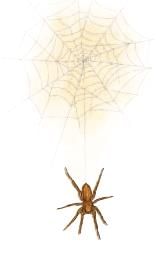 QV. Fill in the blanks by choosing the correct answer from within the brackets
QV. Fill in the blanks by choosing the correct answer from within the brackets
1: The rhyme scheme of the poem is (AABB/ABBA/ABAB)
Ans: AABB
2: ‘Bravo’ is an example of (conjunction/interjection/adjective)
Ans: Interjection
3: The poet uses ‘twas and ‘tis for the sake of (rhythm/rhyme/contraction)
Ans: Contraction
QVI. The spider’s climbing is compared to King Bruce’s own struggles. Just as the spider repeatedly attempts to reach its web, Bruce is trying to achieve a great deed for his people. This poetic device is called a metaphor. It strengthens the poem’s message about perseverance—keep trying till we succeed.
A metaphor is a figure of speech that involves an implied comparison between two unlike things without using ‘like’, ‘as’, or ‘as...as’. It suggests that one thing is another, highlighting similarities between them to add deeper meaning or understanding.
1: Read the following sentences and identify metaphors and similes. Write M for metaphor and S for simile.
Ans:
(i) He ran as fast as a cheetah. – S
(ii) The world is a stage. – M
(iii) The night was as dark as coal. – S
(iv) He sang like an angel. – S
(v) Her voice was music to his ears. – M
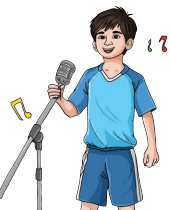
(vi) The classroom was a zoo. – M
(vii) The baby slept like a log. – S
(viii) Her smile was as bright as the sun. – S
(ix) The lake was a mirror, reflecting the sky. – M
2: Read the following sentences and transform the similes to metaphors and metaphors to similes.
(i) Knowledge spreads like the branches of a mighty tree.
Ans: Metaphor: Knowledge is a spreading branch of a mighty tree.
(ii) His courage was a beacon, guiding us through the storm.
Ans: Simile
- His courage was as bright as a beacon guiding us through the storm.
- His courage was like a beacon guiding us through the storm.
(iii) The book was a treasure chest, filled with endless adventures.
Ans: Simile: The book was like a treasure chest, filled with endless adventures.
(iv) Her laughter was a melody that brightened the darkest days.
Ans: Simile: Her laughter was like a melody that brightened the darkest days.
(v) The mountain stood as a guard, watching over the valley below.
Ans: Metaphor: The mountain was a guard, watching over the valley below.
(vi) The night was like a velvet cloak, wrapping the world in mystery.
Ans: Metaphor: The night was a velvet cloak, wrapping the world in mystery.
(vii) Her thoughts were like butterflies in a summer meadow.
Ans: Metaphor: Her thoughts were butterflies in a summer meadow.
Page 21: Let us think and reflect
QI.Read the extracts given below and answer the questions that follow.
1. He flung himself down in low despair,
As grieved as man could be;
And after a while he pondered there,
“I’ll give it all up,” said he.
Now just at that moment a spider dropped,
With its silken, filmy clue;
(i): Select the phrase which shows the physical expression of the King’s emotional state.
Ans: “He flung himself down”
(ii): Why does the poet use the word ‘low’ before despair?
Ans: The word ‘low’ emphasises the depth of King Bruce’s sadness and hopelessness, showing he felt very down emotionally.
(iii): In the line, ‘And after a while he pondered there’, the word ‘pondered’ means ___________
A. paused
B. thought
C. noticed
D. rested
Ans: B. thought
(iv): The phrase ‘silken filmy clue’ creates an image of something that is (long and light/very delicate and soft).
Ans: very delicate and soft
2. “...when it toils so hard to reach and cling, And tumbles every time.”
But up the insect went once more,
Ah me! ‘tis an anxious minute;
He’s only a foot from his cobweb door,
Oh say, will he lose or win it?
(i): Choose the correct option to complete the analogy.
toil: hard:: ___________
A. roll: tumble
B. tumble: circle
C. compress: roll
D. jump: tumble
Ans: A. roll: tumble
(ii): List any two characteristics of the spider highlighted in the line, ‘But up the insect went once more’.
Ans:Two characteristics of the spider highlighted in the line “But up the insect went once more” are:
1. Perseverance – The spider does not give up despite repeatedly falling; it keeps trying again and again.
2. Determination – It is committed to reaching its goal and continues climbing despite difficulties.
(iii): The expression ‘Ah me!’ in the extract indicates a sense of
A. happiness
B. stress
C. relief
D. loneliness
Ans: B. stress
(iv): Complete the sentence with an appropriate reason.
Readers are able to relate to this extract because ______________
Ans: It describes the spider’s struggle and effort, which is similar to the challenges people face when trying to achieve their goals.
QII. Answer the following questions.
1: How does the first stanza help in setting the mood of the poem?
Ans: The first stanza describes King Bruce feeling sad and hopeless, creating a mood of despair and disappointment.
2: Describe how King Bruce’s attitude changes from the beginning towards the end of the poem.
Ans: At the beginning, King Bruce is sad and ready to give up. By the end, he is inspired by the spider’s persistence, becomes determined, and tries again successfully.
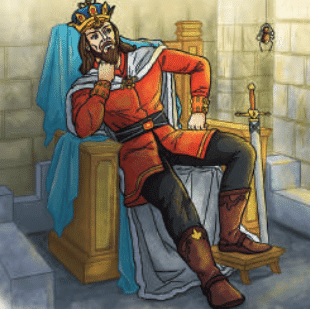
3: The poet describes every action of the spider in great detail. What does this tell us about his attitude towards the spider?
Ans: The poet admires the spider’s hard work and determination, showing respect for its effort and persistence.
4: How does the spider inspire us to overcome despair and not give up?
Ans: The spider keeps trying to reach its web despite falling many times, teaching us to stay strong and keep working towards our goals even after failures.
5: The poem teaches us that failures are stepping stones to success. Explain.
Ans: The poem shows that the spider failed nine times but succeeded on the tenth try. Similarly, King Bruce failed but succeeded after trying again, proving that failures help us learn and lead to success.
6: The spider’s journey tells us that anyone can be a source of inspiration in our lives. Elaborate.
Ans: The spider, a small creature, inspires King Bruce to keep trying. This shows that inspiration can come from unexpected sources, like nature or everyday things, encouraging us to stay determined.
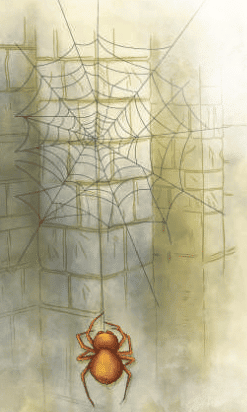
Page 22: Let us learn
QI: Write the opposites of the following words taken from the poem.
1. up × _____________
2. fast × _____________
3. glad × _____________
4. win × _____________
5. succeed × _____________
Ans:
1. up × down
2. fast × slow
3. glad × sad
4. win × lose
5. succeed × fail
QII: Choose the correct meaning of the underlined words in the following sentences from the box given below. Frame sentences of your own for these words.

Ans:
(i) endeavour – an attempt to do something new or difficult
- Sentence: I will make every endeavour to finish my project on time.
(ii) toil – work very hard and/or for a long time
- Sentence: Farmers toil in the fields to grow crops for us.
(iii) strive – to try very hard to achieve something
- Sentence: Students should strive to improve their skills every day.
(iv) braced – prepared themselves for something difficult
- Sentence: The team braced itself for the tough match ahead.
QIII: The poem uses words that show distance. For example: a long way up, inch by inch, higher and higher, half-yard higher. Classify the words or phrases in the box given below based on the distance (far or near) and write in the space provided. You may take the help of a dictionary.
 Ans:
Ans:
Far: middle of nowhere, remoteness, yonder, afar, light year, farther
Near: proximity, vicinity, adjacent, a stone’s throw, hairline
QIV: Read the following line from the poem.
‘Twas a delicate thread it had to tread,"
Now repeat the lines five to six times. Are you able to say it clearly? Create more tongue twisters of your own.
Ans:
- Yes, I can say the line clearly after repeating it five to six times.
- Tongue twisters:
- Swift spiders spin strong silk strands.
- Clever crabs crawl cautiously close.
- Tiny turtles tap tough twigs tightly.
Page 24: Let us listen
I. You will listen to a story about an ant. Read the questions given below and before you listen, guess the answers to these questions.
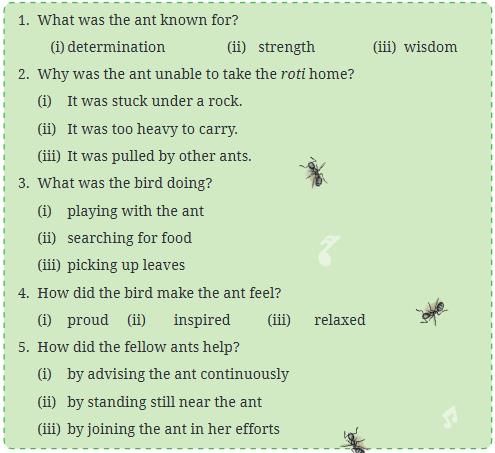 (Transcript for the teacher)
(Transcript for the teacher)
Hello everyone, I’m sure you have enjoyed learning about King Bruce and the spider. Let me share another story with you.
In a thick green forest, there lived a little ant. She was known for her determination and never-give-up attitude. One sunny day, the ant found a delicious piece of roti that was too big for her to carry alone.
“This crumb is huge, but I must get it back to the anthill. My family will be so happy!” she thought to herself.
She tried to lift the crumb with all her might, but it was too heavy. She tried pushing it, pulling it and even rolling it, but nothing seemed to work. Exhausted and saddened, she sat down and began to cry.
As the ant sat there, feeling beaten, she noticed a small bird nearby. The bird was trying to build a nest. It picked up twigs and leaves, but every time it tried to place them, the wind would blow them away. However, the bird did not give up. It kept trying, over and over again, until finally, it managed to build a strong nest.
“If that bird can keep trying and succeed, then I shouldn’t give up either,” she thought, feeling inspired.
Determined once more, the ant gathered all her strength and decided to try again. She called her fellow ants for help. Together, they formed a chain and lifted the crumb with their combined strength. Slowly but surely, they carried the crumb back to the anthill.
“We did it! Thank you, everyone! We showed that with teamwork and never giving up, we can achieve anything!” the ant shouted, excited and grateful.
She and her friends celebrated their success.
We too should learn this lesson from the ant’s experience—never give up, no matter how difficult the situation may seem.
Hope you all liked the story.
Thank you!
Ans:
1. What was the ant known for?
(i) determination
2. Why was the ant unable to take the roti home?
(ii) It was too heavy to carry.
3. What was the bird doing?
(iii) picking up leaves
4. How did the bird make the ant feel?
(ii) inspired
5. How did the fellow ants help?
(iii) by joining the ant in her efforts
II. Now, listen to the story once again, and as you listen, check whether your answers are correct.
1. What was the ant known for?
Correct answer: (i) determination
The story states: “She was known for her determination and never-give-up attitude.”
2. Why was the ant unable to take the roti home?
Correct answer: (ii) It was too heavy to carry
It is mentioned that “She tried to lift the crumb with all her might, but it was too heavy.”
3. What was the bird doing?
Correct answer: (iii) picking up leaves
The bird was building a nest using twigs and leaves.
4. How did the bird make the ant feel?
Correct answer: (ii) inspired
After watching the bird’s repeated attempts, the ant felt inspired to try again.
5. How did the fellow ants help?
Correct answer: (iii) by joining the ant in her efforts
The ants worked together and carried the crumb back to the anthill using teamwork.
Page 25: Let us speak
Q: Narrate a personal experience about a time when you were motivated by someone or something to carry on and never give up. Your perseverance helped you.
Ans:
My Experience of Perseverance
Introduction:
I remember a time when I felt like giving up. It was when I was trying to learn how to ride a bicycle last summer during my school holidays.
Describe the challenge:
The challenge I faced was balancing on the bicycle without falling. I was struggling with keeping the bike steady, and every time I pedaled, I would wobble and fall off. The problem seemed too big because I kept falling and scraping my knees, and I thought I would never learn.
Feeling disheartened:
At first, I felt discouraged and thought about giving up because I was tired of falling again and again. I didn’t think I could succeed because my friends could already ride, and I felt I was too clumsy. I felt upset and wanted to leave because it was so hard, and I was scared of getting hurt.
The source of motivation:
But then, I remembered the poem "King Bruce and the Spider" that we read in class. In the poem, the spider kept trying to climb its web even after falling nine times, and it finally succeeded. The spider inspired me to keep going because if a tiny spider could be so brave and not give up, then I could try harder too.
Taking action:
After feeling inspired, I decided to practice every day, even if I fell. I gathered my strength and asked for help from my older brother, who held the bike for me while I pedaled. With a new sense of willpower, I kept trying, focusing on balancing and pedaling slowly.
The result:
In the end, I was able to ride the bicycle all by myself after a week of practice! Thanks to standing firm and never giving up, I achieved my goal of riding without falling. I felt proud because I could now ride with my friends in the park, and they cheered for me. It was worth it because I had so much fun and felt braver.
Reflection:
This experience taught me that even when things are hard, I should keep trying and not give up. I learned that perseverance is the key to success, just like the spider in the poem. Now, I always remember to be patient and keep practicing when I face something difficult. The lesson I learned from this is that if I don’t give up, I can achieve anything!
Note for Class 7 Students: You can change the story to something that happened to you, like learning to swim, solving a tough math problem, or winning a race. Use the prompts to tell your own story, and think about what motivated you—like a story, a person, or even the spider from the poem!
Page 26: Let us write
Q: Think about the steps you can take to overcome a difficult situation and write them down. Now, write a letter to your cousin on how you plan to overcome any difficult situation. Also, advise not to quit and persevere.
Remember to use transition words like ‘To begin with…,’ ‘Next…,’ ‘After that…,’ ‘Then...,’ ‘Finally...,’ to share the steps of your plan. You may begin this way: Ans:
Ans:
Steps to overcome a difficult situation:
- Stay calm and think clearly about the problem.
- Make a plan with small, achievable steps.
- Ask for help from family, friends, or teachers.
- Keep trying, even if I fail at first.
- Stay positive and believe in myself.
Letter:
20, Rajendra Nagar
Jeevanpur
23 August 20XX
Dear Monika,
Thank you for your letter inquiring about how I handle challenging situations. I’ve thought about it, and I have a plan to overcome difficulties. To begin with, I stay calm and think about the problem. Next, I make a plan with small steps to solve it. After that, I ask for help from my family or teachers if needed. Then, I keep trying, even if I fail at first. Finally, I stay positive and believe in myself.
My advice to you is never to give up, no matter how hard things seem. Like the spider in the poem “Try Again,” keep trying until you succeed. Perseverance always pays off!
Yours affectionately,
Deepa
Page 26: Let us Explore
(I) Collect folk songs in your own language that connect us with nature and compile them as a class project.
Ans: Folk songs are traditional songs that people have been singing for many years. They often tell stories about nature, daily life, festivals, and our culture. Collecting folk songs in our own language helps us connect with our roots and understand how people appreciate nature around them.
For the class project, we can:
- Ask family members, elders, and neighbors to share folk songs they know about rivers, trees, animals, seasons, and farming.
- Write down the lyrics and record the songs if possible.
- Find out what these songs mean and how they show love and respect for nature.
- Compile all the songs in a booklet or a digital file and present it in class.
This project will help us learn about our culture and how nature has inspired people through songs.
(II) Did you know that spiders are not insects? They belong to a group called the arachnids. Observe a spider and an ant from a distance and note down the differences between them. Share your observations with your classmates. Ask your Science teacher for more information to know about spiders better.
Ans: 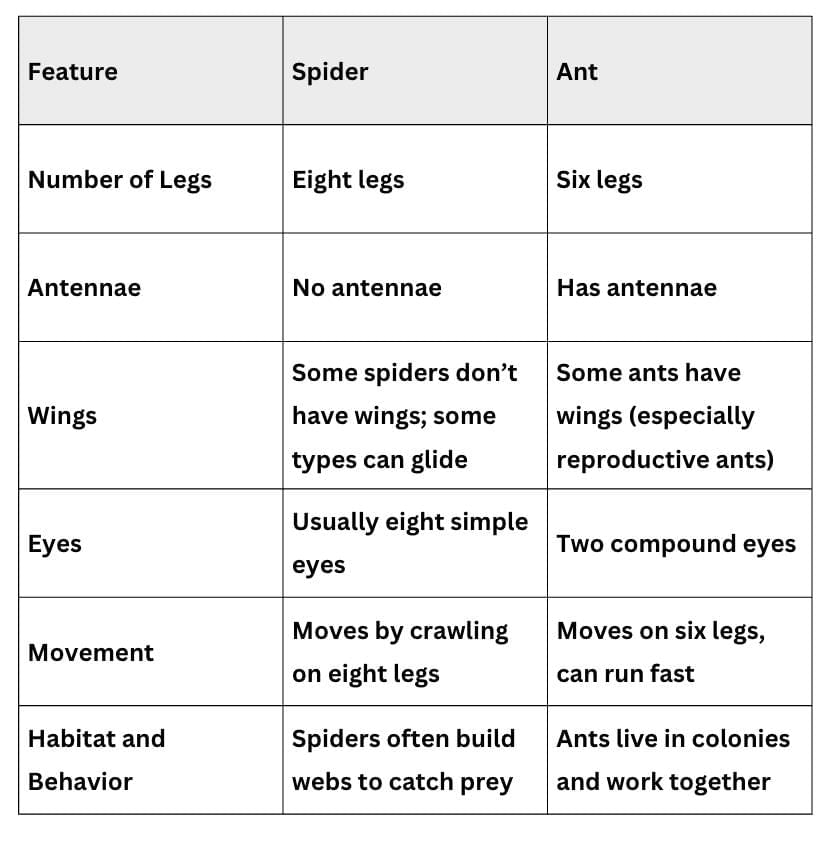
III Let us learn how to weave a spider web.
1. Take three sticks (each about eight inches long) and a roll of old wool.
2. Tie the sticks together in the centre with the wool (Fig. 1).
3. Start weaving the web by putting a loop around every stick (Figs. 2 and 3).
4. Complete the web and tie the thread in a knot on the stick where the web is complete (Fig. 4).
Now, decorate it with words and phrases you learnt about the spider in the poem or anything else that you like.
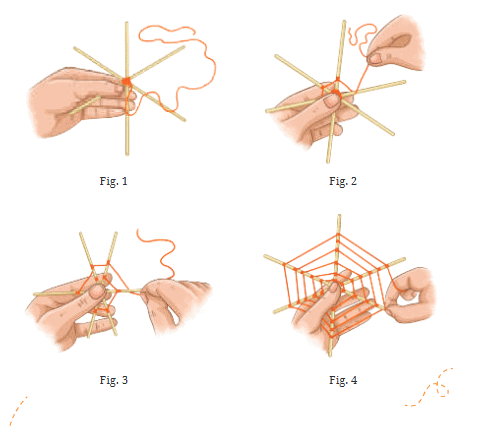
Ans: Now, let’s decorate the web with words and phrases from the poem about the spider! We can write these on small pieces of paper and stick them on the web, or use a marker to write on the wool. Here are some words and phrases from the poem:
- Silken thread (the poem says “silken, filmy clue” for the spider’s web).
- Cobweb home (the spider is trying to reach its “cobweb home”).
- Strong endeavour (the spider climbs with “strong endeavour”).
- Nine attempts (the spider tries nine times to reach its goal).
- Defied despair (the poem says the spider “defied despair”).
You can also add a fun phrase like “Bravo, spider!” because King Bruce cheers for the spider when it succeeds. If you want, you can draw a little spider on the web or add glitter to make it look shiny like a real web!
|
55 videos|465 docs|76 tests
|
FAQs on NCERT Solutions for Class 7 English Unit 1 Try Again
| 1. What is the main theme of the chapter "Try Again"? |  |
| 2. How does the author illustrate the concept of trying again in the chapter? |  |
| 3. What life lessons can be learned from "Try Again"? |  |
| 4. Can you explain the role of encouragement in the chapter "Try Again"? |  |
| 5. How can the message of "Try Again" be applied in everyday life? |  |

















